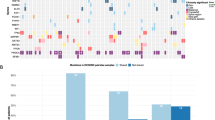Abstract
Introduction
Ductal carcinoma in situ (DCIS) is considered to be related to the development of invasive breast cancer. The aim of molecular biological research of preinvasive breast lesion characteristics and comparison with normal tissues and tissue of invasive tumours is to identify patients at high risk of developing invasive tumour on the basis of already established preinvasive lesions, and thus influence clinical decision-making. The aim of our study was to analyse several key molecules involved in different cellular pathways important for cancer development and progression in different types of breast tissue and to describe similarities and differences between premalignant and malignant lesions.
Material and methods
Genetic material isolated from both the tumour and healthy tissue was examined by loss of heterozygosity (LOH) analysis and real-time PCR using collagen 2A as a house-keeping gene.
Results
We analysed 65 samples of healthy mammary gland, 25 DCIS and 42 invasive ductal breast cancer samples. We analysed the LOH in three genes: BRCA1, BRCA2 and p53; and the gene expression of the VEGF gene and Bcl-2 gene. LOH in the BRCA1 gene was present in 44.74% of invasive samples and in 8.69% of DCIS (p=0.026); LOH in the BRCA2 gene in 45.0% of invasive samples and in 9.52% of DCIS (p=0.036); LOH in the p53 gene in 32.5% of invasive samples and in 31.82% of DCIS (p=0.97). No LOH was observed in normal tissue samples. VEGF was overexpressed in 14.3% of invasive cancers and in 12.0% of DCIS. Overexpression of Bcl-2 was observed in 11.9% of invasive cancers and in 8.0% of DCIS.
Conclusion
We have confirmed that some of the molecular characteristics of DCIS are identical to those of invasive carcinoma. This approach could lead to the identification of molecular markers as indicators for the potential development of DCIS into invasive carcinoma or identification of DCIS subgroups with latent invasion.
Similar content being viewed by others
References
Allred DC, Wu Y, Mao S et al (2008) Ductal carcinoma in situ and the emergence of diversity during breast cancer evolution. Clin Cancer Res 14:370–378
Hieken TJ, Cheregi J, Farolan M et al (2007) Predicting relapse in ductal carcinoma in situ patients: an analysis of biologic markers with long-term follow-up. Am J Surg 194:504–506
Hieken TJ, Farolan M, D'Alessandro S, Velasco JM (2001) Predicting the biologic behavior of ductal carcinoma in situ: an analysis of molecular markers. Surgery 130:593–600; discussion 600–591
Sakorafas GH, Farley DR, Peros G (2008) Recent advances and current controversies in the management of DCIS of the breast. Cancer Treat Rev 34:483–497
Abdel-Fatah TM, Powe DG, Hodi Z et al (2008) Morphologic and molecular evolutionary pathways of low nuclear grade invasive breast cancers and their putative precursor lesions: further evidence to support the concept of low nuclear grade breast neoplasia family. Am J Surg Pathol 32:513–523
Farabegoli F, Champeme MH, Bieche I et al (2002) Genetic pathways in the evolution of breast ductal carcinoma in situ. J Pathol 196:280–286
Zagouri F, Sergentanis TN, Zografos GC (2007) Precursors and preinvasive lesions of the breast: the role of molecular prognostic markers in the diagnostic and therapeutic dilemma. World J Surg Oncol 5:57
Leong AS, Sormunen RT, Vinyuvat S et al (2001) Biologic markers in ductal carcinoma in situ and concurrent infiltrating carcinoma. A comparison of eight contemporary grading systems. Am J Clin Pathol 115:709–718
Smith KL, Adank M, Kauff N et al (2007) BRCA mutations in women with ductal carcinoma in situ. Clin Cancer Res 13:4306–4310
Hu M, Yao J, Carroll DK et al (2008) Regulation of in situ to invasive breast carcinoma transition. Cancer Cell 13:394–406
Shekhar MP, Tait L, Pauley RJ et al (2008) Comedoductal carcinoma in situ: A paradoxical role for programmed cell death. Cancer Biol Ther 7:1774–1782
Kataoka N, Cai Q, Wen W et al (2006) Population-based case-control study of VEGF gene polymorphisms and breast cancer risk among Chinese women. Cancer Epidemiol Biomarkers Prev 15:1148–1152
Viacava P, Naccarato AG, Bocci G et al (2004) Angiogenesis and VEGF expression in preinvasive lesions of the human breast. J Pathol 204:140–146
Pfaffl MW (2001) A new mathematical model for relative quantifi cation in real-time RT-PCR. Nucleic Acids Res 29:e45
Pfaffl MW, Horgan GW, Dempfle L (2002) Relative expression software tool (REST) for group-wise comparison and statistical analysis of relative expression results in real-time PCR. Nucleic Acids Res 30:e36
Boocock CA, Charnock-Jones DS, Sharkey AM et al (1995) Expression of vascular endothelial growth factor and its receptors fl t and KDR in ovarian carcinoma. J Natl Cancer Inst 87:506–516
Bourgarel-Rey V, Savry A, Hua G et al (2009) Transcriptional down-regulation of Bcl-2 by vinorelbine: identification of a novel binding site of p53 on Bcl-2 promoter. Biochem Pharmacol 78:1148–1156
Larson PS, de las Morenas A, Cerda SR et al (2006) Quantitative analysis of allele imbalance supports atypical ductal hyperplasia lesions as direct breast cancer precursors. J Pathol 209:307–316
Reis-Filho JS, Lakhani SR (2003) The diagnosis and management of pre-invasive breast disease: genetic alterations in pre-invasive lesions. Breast Cancer Res 5:313–319
Vogl G, Dietze O, Hauser-Kronberger C (2005) Angiogenic potential of ductal carcinoma in situ (DCIS) of human breast. Histopathology 47:617–624
Author information
Authors and Affiliations
Corresponding author
Rights and permissions
About this article
Cite this article
Zikan, M., Bohm, J., Pavlista, D. et al. Comparative analysis of loss of heterozygosity and expression profi le in normal tissue, DCIS and invasive breast cancer. Clin Transl Oncol 13, 652–655 (2011). https://doi.org/10.1007/s12094-011-0710-1
Received:
Accepted:
Published:
Issue Date:
DOI: https://doi.org/10.1007/s12094-011-0710-1




